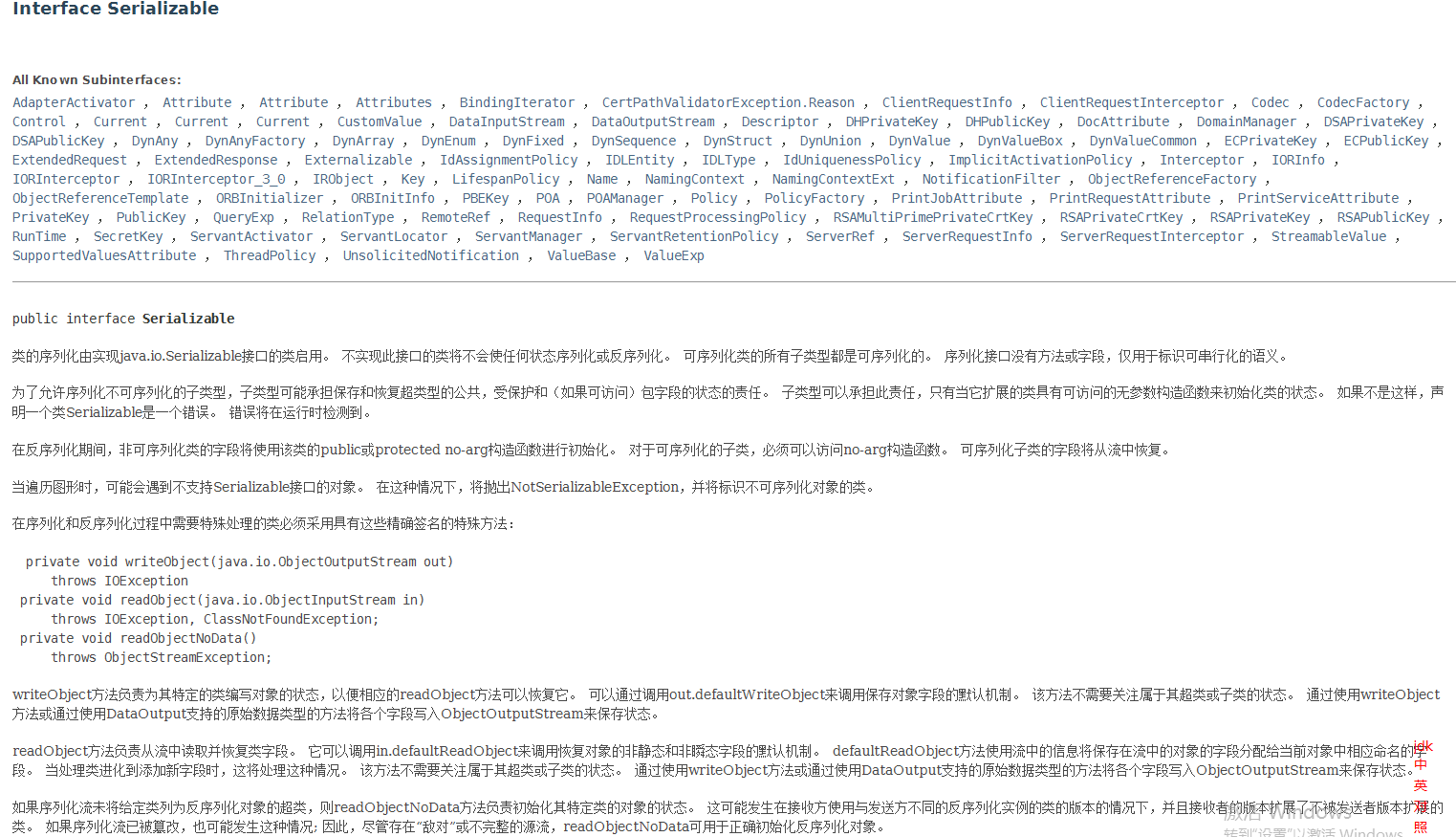Externalizable vs Serializable
Externalizable和Serializable的一些比较点,如下:
【1】 Serializable 是标识接口
public interface Serializable { }
public interface Externalizable extends java.io.Serializable { void writeExternal(ObjectOutput out) throws IOException; void readExternal(ObjectInput in) throws IOException, ClassNotFoundException; }
Externalizable 接口继承于Serializable,实现该接口,需要重写readExternal和writeExternal方法~
【2】Serializable提供了两种方式进行对象的序列化,
- 采用默认序列化方式,将非transatient和非static的属性进行序列化
- 编写readObject和writeObject完成部分属性的序列化
Externalizable 接口的序列化,需要重写writeExternal和readExternal方法,并且在方法中编写相关的逻辑完成序列化和反序列化。
【3】Externalizable接口的实现方式一定要有默认的无参构造函数~
- 如果,没有无参构造函数,反序列化会报错~ 验证一下~ Book添加一个有参数的Book构造函数~
- Serializable接口实现,其采用反射机制完成内容恢复,没有一定要有无参构造函数的限制~
【4】采用Externalizable无需产生序列化ID(serialVersionUID)~而Serializable接口则需要~
【5】相比较Serializable, Externalizable序列化、反序列更加快速,占用相比较小的内存
在项目中,大部分的类还是推荐使用Serializable, 有些类可以使用Externalizable接口,如:
- 完全控制序列的流程和逻辑
- 需要大量的序列化和反序列化操作,而你比较关注资源和性能~ 当然,这种情况下,我们一般还会考虑第三方序列化/反序列化工具,如protobuf等进行序列化和反序列化操作~
API的说明
Externalizabl:

Serializable

DEMO
import java.io.Serializable; import java.util.List; /** * @Type Book.java * @Desc * @author wangmengjun * @date 2017年12月1日 下午7:16:29 * @version */ public class Book implements Serializable { private static final long serialVersionUID = -6212470156629515269L; /**书名*/ private String name; /**ISBN*/ private String isbn; /**作者*/ private List<String> authors; /** * @return the name */ public String getName() { return name; } /** * @param name the name to set */ public void setName(String name) { this.name = name; } /** * @return the isbn */ public String getIsbn() { return isbn; } /** * @param isbn the isbn to set */ public void setIsbn(String isbn) { this.isbn = isbn; } /** * @return the authors */ public List<String> getAuthors() { return authors; } /** * @param authors the authors to set */ public void setAuthors(List<String> authors) { this.authors = authors; } /* (non-Javadoc) * @see java.lang.Object#toString() */ @Override public String toString() { return "Book [name=" + name + ", isbn=" + isbn + ", authors=" + authors + "]"; } }
import java.io.BufferedInputStream; import java.io.BufferedOutputStream; import java.io.FileInputStream; import java.io.FileOutputStream; import java.io.IOException; import java.io.ObjectInputStream; import java.io.ObjectOutputStream; /** * @Type SerializationUtil.java * @Desc * @author wangmengjun * @date 2017年12月1日 下午7:23:04 * @version */ public class SerializationUtil { /** * 从一个给定的文件完成反序列化 */ public static Object deserialize(String fileName) throws IOException, ClassNotFoundException { FileInputStream fis = new FileInputStream(fileName); BufferedInputStream bis = new BufferedInputStream(fis); ObjectInputStream ois = new ObjectInputStream(bis); Object obj = ois.readObject(); ois.close(); return obj; } /** * 将给定的对象序列化到指定的文件中去 */ public static void serialize(Object obj, String fileName) throws IOException { FileOutputStream fos = new FileOutputStream(fileName); BufferedOutputStream bos = new BufferedOutputStream(fos); ObjectOutputStream oos = new ObjectOutputStream(bos); oos.writeObject(obj); oos.close(); } }
public class SerializableTest { public static void main(String[] args) throws IOException, ClassNotFoundException { Book book = new Book(); book.setIsbn("ABC123456789"); book.setName("Hello Java"); book.setAuthors(Arrays.asList("John","Eric")); //book==>Book [name=Hello Java, isbn=ABC123456789, authors=[John, Eric]] System.out.println("book==>" + book); /** * 将book对象序列化到book.temp文件中去 */ String fileName = "book.temp"; SerializationUtil.serialize(book, fileName); /** * 从book.temp文件中,反序列化一个Book对象 */ Book deserializedBook = (Book) SerializationUtil.deserialize(fileName); //deserializedBook==>Book [name=Hello Java, isbn=ABC123456789, authors=[John, Eric]] System.out.println("deserializedBook==>" + deserializedBook); } }
部分属性序列化
如果只想将部分属性进行序列化,可以采用如下几种方法:
- 使用transient关键字
- 添加writeObject和readObject方法
- 使用Externalizable实现
使用transient关键字
public class Book implements Serializable { private static final long serialVersionUID = -6212470156629515269L; /** 书名 */ private String name; /** ISBN */ private transient String isbn; /** 作者 */ private transient List<String> authors; ... ... }
重写writeObject和readObject方法
另外,我们也可以采用编写私有方法writeObject和readObject,完成部分属性的序列化。修改Book类,增加writeObject 和 readObject方法,如:
public class Book implements Serializable { private static final long serialVersionUID = -6212470156629515269L; /** 书名 */ private String name; /** ISBN */ private String isbn; /** 作者 */ private List<String> authors; private void writeObject(ObjectOutputStream oos) throws IOException { // oos.defaultWriteObject(); oos.writeObject(name); oos.writeObject(isbn); } private void readObject(ObjectInputStream ois) throws IOException, ClassNotFoundException { // ois.defaultReadObject(); name = (String) ois.readObject(); isbn = (String) ois.readObject(); } ... ... }
使用Externalizable实现
还有一种方式,就是使用Externalizable完成部分属性的序列化。
Externalizable继承自Serializable,使用Externalizable接口需要实现writeExternal以及readExternal方法~在writeExternal方法中,写入想要外部序列化的元素~
import java.io.Externalizable; import java.io.IOException; import java.io.ObjectInput; import java.io.ObjectOutput; import java.util.List; /** * @Type Book.java * @Desc * @author wangmengjun * @date 2017年12月1日 下午7:16:29 * @version */ public class Book implements Externalizable { /** 书名 */ private String name; /** ISBN */ private String isbn; /** 作者 */ private List<String> authors; @Override public void writeExternal(ObjectOutput out) throws IOException { out.writeObject(name); out.writeObject(isbn); } @Override public void readExternal(ObjectInput in) throws IOException, ClassNotFoundException { name = (String) in.readObject(); isbn = (String) in.readObject(); } /** * @return the name */ public String getName() { return name; } /** * @param name * the name to set */ public void setName(String name) { this.name = name; } /** * @return the isbn */ public String getIsbn() { return isbn; } /** * @param isbn * the isbn to set */ public void setIsbn(String isbn) { this.isbn = isbn; } /** * @return the authors */ public List<String> getAuthors() { return authors; } /** * @param authors * the authors to set */ public void setAuthors(List<String> authors) { this.authors = authors; } /* * (non-Javadoc) * * @see java.lang.Object#toString() */ @Override public String toString() { return "Book [name=" + name + ", isbn=" + isbn + ", authors=" + authors + "]"; } }